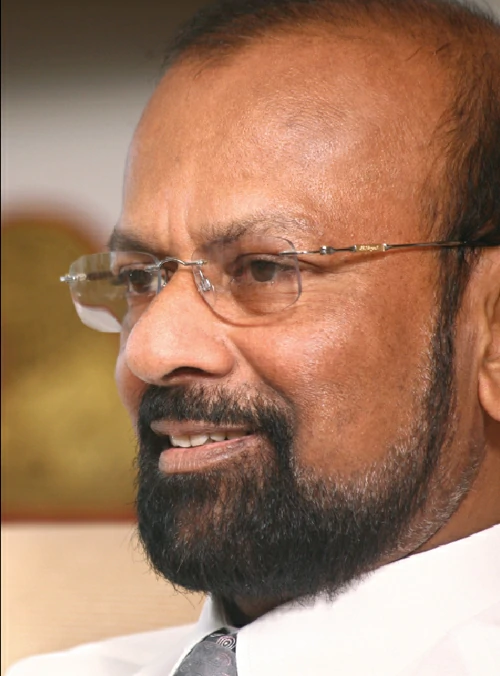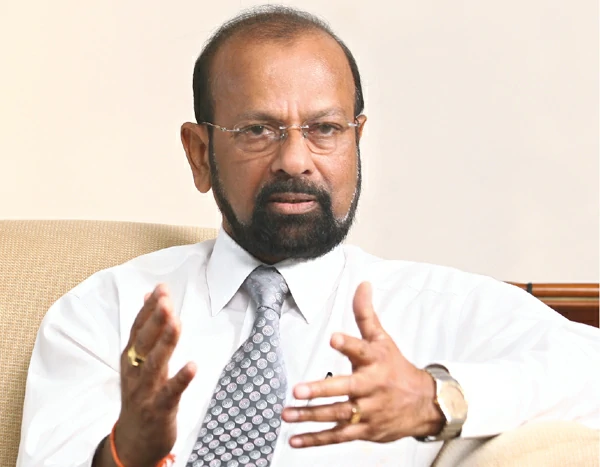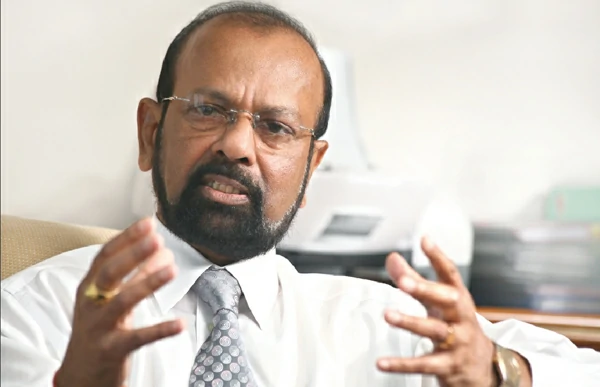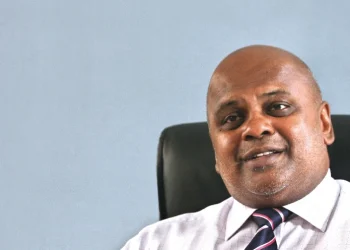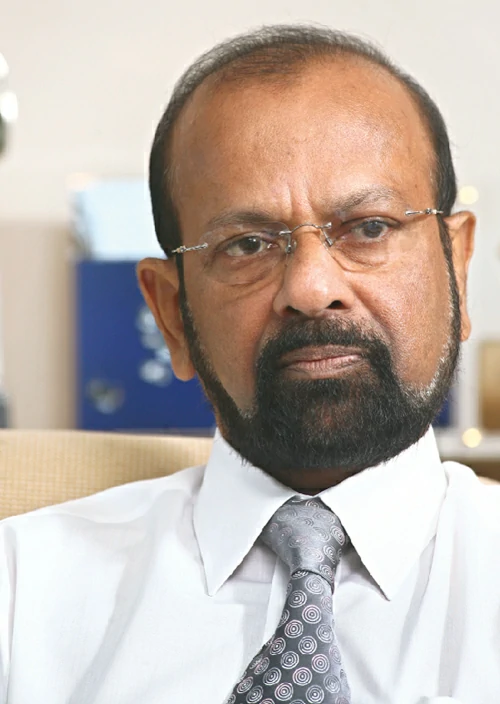
Bank of Ceylon, the beacon of the nation, celebrated its 70th anniversary recently. Abiding by its strong responsibility towards the nation, the Bank supported the country through its most turbulent years unwaveringly. Today, it proudly shares the joy of the beginning of a new era, leading the nation on its way towards reconstruction and development. The present Chairman of Bank of Ceylon is Dr Gamini Wickramasinghe, who is also the founder of Informatics Group that pioneered the concept of locally based quality British tertiary education in Sri Lanka. In a pursuit to unravel the way forward, Business Today spoke to Dr Gamini Wickramasinghe, whose far-reaching vision, utmost dedication and meticulous guidance earned much prestige for the Bank.
Interviewed by Keith Bernard | Compiled by Nishani Perera | Photography by Menaka Aravinda
As Chairman of probably the largest commercial bank in Sri Lanka with a local branch network of over 300, a wide customer base and a history of over 70 years of operation, how would you like to describe Bank of Ceylon?
We are the largest bank in Sri Lanka and we cater to many sectors all over the country. We cater to not just the corporate sector, but even to the grass roots level with rural finance being a priority. As we are also a government bank, our focus is not on profit making per se but on national development activities.
Through its history, Bank of Ceylon has stood as a symbol of all banking in Sri Lanka. As someone who has been associated with private enterprise throughout your career, how would you compare the culture and efficiency of the Bank with that of a comparable business in the private sector?
The Bank had a private sector working culture prior to nationalisation in 1961. Post nationalisation, it is obvious that our stance should tally with the goals of the economy. Hence we are currently not focused solely on profits. Take for example the case of BOC operating in Mankulam, Kilinochchi and Mullaitivu during troubled times. We have been there for 26 years. As for other banks, none were there. Our service is to the people. As for private banks, they will look in to the normal risk-return dynamics before engaging in any activity.
The Bank and its employees have in many ways led and transformed this industry. Even today we are leading the industry in several core businesses. I believe it is a general myth that government departments are not as dynamic as those in the private sector due to various structural differences. Then again today we are all in the IT era. Therefore we are all comparably the same. If we look at efficiency, in terms of getting a transaction done, we are equal to any other bank. In terms of our staff’s knowledge and professionalism, we are extremely strong. It is simply that we have a different business focus than that of the private sector.
The global financial meltdown is bound to have an adverse impact on the financial sector in Sri Lanka as well. How profound do you think the effect of the global recession will be on Sri Lanka and in particular on your bank in the current year?
Looking at 2008, when the international markets crashed in the countries like the US, the UK and also the big financial institutions, nothing like that happened here. However we are feeling some trickle-down effects. If you look at the West, when they experienced it, they lost jobs, they lost money and their buying power went away. The impact on our economy is more muted.
Although Financial Institutions Felt The Strain Of The Lack Of Liquidity And High Costs Due To The Rate Environment, We Now Have A Much Better Control Over It. Especially, The Finality In Ending The War Has Created Optimism For The Future Direction Of Our Economy.
The financial sector of Sri Lanka has been under great stress during the year so far and that has forced many businesses to go down, default on debt, erode the entrepreneurial and corporate spirit, scale down and retrench . Do you see the problem in the same lens or differently, and as a large and responsible financial institution how do you protect your interests and grow?
Certainly the industry has undergone stresses during the past year. In terms of default rates, it is normalcy for a bank to maintain a tolerable amount of non performing loans and advances.
Our NPA rate at the year end was 4.9 percent on a corporate and retail portfolio and it was close to Rs 300 billion. In fact our NPA ratio was the lowest in the industry. Although financial institutions felt the strain of the lack of liquidity and high costs due to the rate environment, we now have a much better control over it. Especially, the finality in ending the war has created optimism for the future direction of our economy. The rate environment and financial market conditions have repositioned. Therefore, overall the industry’s difficulties have eased.
As financial institutions you can action your recovery and litigation process with a view to minimising your exposure, but it may not be completely successful as many defaulters may not be able to pay up anyway. What other recourse do you think could potentially address the problem? Is there any possibility to help businesses to recover and moreover proactively prevent the problem from returning in the future?
We have had customers who have experienced difficulties. We look at these customers on a case specific basis. Our customers are valuable to us and we aim at finding the right solutions for them. Where we have identified customers who are genuinely experiencing difficulties, we assist them by rescheduling loans or giving them relatively more flexible terms. It is only in the case of willful defaulters that litigation is a means to an end. As a national bank we don’t want companies to close down. This will have negative economic implications.
We try to keep companies running; people employed; and the economy moving. Currently we are transforming our strategies relating to recoveries. This new strategy is a cross between just pure lending and investment banking. It broadly encompasses far more than just rescheduling or restruc-turing payments. We play the role of a rehabilitator where the company is distressed. We may even consider a hybrid debt and equity financing option, depending on the evaluation of the company’s future prospects. These new activities will be handled by a dedicated Investment Unit. You can expect private equity to be a strong focus for us in the future.
Will BOC be looking at Investment Banking in terms of corporate advising?
Yes, the unit will take up certain corporate advisory activities. However it will not be limited to corporate advisory activities. We are considering many other fund and fee based activities that can be classed as investment banking. In addition to our focus on distressed companies, restructuring and private equity, we will consider wealth and asset management in the institutional brokerage side. Also some debt and equity distribution activities may be on the cards, selectively.
We Have Been In The Conflicting Areas Throughout The War For 26 Years, Mainly In The Three Cities Of Mankulam, Kilinochchi And Mullaitivu. Therefore Going In To The North And East Is Not New To Us. We Are Already There.
A large part of your lending in the past has been to the Government and a significant portion of your Non Performing Advances to the government were converted to Sri Lanka Development Bonds to reduce your loan base. What is your comment on this?
These were not non performing advances but performing loans. The conversion of Government loans to Development Bonds was effected for strategic reasons. Converting loans, which are an asset to bonds and investment, did not impact exposure risk. It improved the liquidity due to the bonds being negotiable instruments and also yielded higher returns than when retained on the balance sheet as loans.
There is hope among the business community that since the war has come to an end, Sri Lanka would pick up with the North East development, restructuring and the private sector rejuvenation. How do you see this?
We see the North and East as being capable of providing a significant impact on the economy’s upward growth trajectory. There are pressing investment needs in these provinces. Most economic sectors in these areas remain underbanked, therefore, financial intermediation led development has a lot of potential. Resources can be allocated to import export activity, agriculture, livestock and fisheries, tourism and industries. We however foresaw opportunities in these provinces months ago. We went on a drive for low cost deposits, as with the ‘Gam Udana’ programme which collected over Rs 9 billion so that we will have the flexibility to lend a hand in the rehabilitation process. Overall, the war ending has had a visible impact on business sentiment.
Now that Sri Lanka is returning to normalcy after a long conflict that plagued the country and stifled growth for nearly three decades, what plans are underway for BOC to enhance its foothold in the North and East? How great do you think your expanded business in the North and East would influence your growth in the near future?
You may have seen certain things in the papers recently. Anyway, before the war ended, in early May, when the IDPs started trickling in to the Government control areas, that was the time we moved in to help those people. Prior to that too, I must say that we have been in the North and in the East. We have been in the conflicting areas throughout the war for 26 years mainly in the three cities of Mankulam, Kilinochchi and Mullaitivu. Therefore going in to the North and East is not new to us. We are already there. Now with the IDPs coming into the Government control areas, we are firmly established there. We have opened five branches in the Manik Fram, in five zones. What we mean here by a branch is a 40 foot container, with the latest ATM, online banking, a section for pawn brokering and other banking services like fixed deposits, debit cash outs and like any other banking service that we provide anywhere else. It is for the people there. We have even issued 10,000 ATM cards. We have installed points-of-sales, supermarkets, SATHOSA’s and others where they do not even have to carry cash; they can use their cards. Likewise we are firmly entrenched. Going back, I was in Vavuniya a few times and then in Jaffna. We met the Chambers, the Vice Chancellor, the GA, academics and all sectors of the markets like fisheries, agriculture, animal husbandry and people from different walks of life.
The Government has a plan, the ‘Uthuru Vasanthaya’ and the ‘Nagenahira Navodaya’. We are also fitting in to those plans. As for what we have been doing in the North and East in the past, now there are new requirements. When we talked to them about what they want after the war, we realised their needs and now we are catering to some of those needs immediately. We have set up our own budgets for the North and East. We are also working on some credit lines with some foreign governments and some other financial institutions and supporters, to support the North and East. We have big plans and we are already there in action. Currently we have 31 large and small branches in the North. We are not waiting for the Government to go and do all those things. We know now, what we have to do. We will go and do it and we are not there because of the money.
The country also has a responsibility to go and help those people.
The IMF Facility Improves The Reserve Position Of The Country.This Means That BOC Will Be In A Stronger Position To Mobilise Funds From The International Market Through Syndication And The Sale Of Other Products.
The Bank gives significance to the agricultural sector in Sri Lanka. Can you elaborate on this?
It should be noted that Sri Lanka is still an agricultural nation. Despite the significance of Industry and Services most of the population depend on it. We can optimise the amount of land we use. If you get the right seed material, planting material, techniques, technology and all that, I feel that a tenth of the land we are using will be more than sufficient.
Mahaweli is a good experience. This year they did not have water, which posed real challenges for the farmers. This situation will hold in the future too, perhaps at a more intense level. We may have to come up with alternative crops and high yield varieties to counter such challenges. We do have water in the rivers, but we need to be able to use it.
At the Bank we look at the agricultural sector as very significant. Much of our Small and Medium Enterprises and Microfinance activities are focused on this sector. We look at the sector through the output angle. Inflation was the real target here. Of the new index, nearly 50 percent of inflation is food and allied items.
The Bank understands that certain agricultural sectors need financing to reach maximum efficiency. Improving production will always have a salutary impact on inflation, more so that it will create an ability for substitution of imports and opportunities for employment and self-sufficiency. On the import substitution, if we take milk powder imports, we imported about Rs 32 billion worth of milk powder last year. Now think of a large dairy with about 1000 cows in the way of a corporate business. That will help reduce importing milk from one percent or two percent statistically, saving the much needed foreign exchange.
The Bank also sponsors a programme on Rupavahini called ‘Rividina Arunella’ based on home gardening which has a large viewership. The end aim is to propagate agriculture.
Now that the IMF loan has come through how optimistic are you about your own performance as a bank and the general performance of the sector resulting from the IMF facility?
The IMF facility improves the reserve position of the country. This means that BOC will be in a stronger position to mobilise funds from the international market through syndication and the sale of other products.
Do you think we would have some kind of an implication on the Forex Market with dollars coming in to the system?
No. The IMF facility is not expected to have rate implications on the Forex Market. In the recent past we have observed large inflows from the diaspora having the impact of lowering rates. This enables us to reduce Forex lending rates thereby helping the external sector related industries. It is expected that the Forex Market can experience some fluctuation as a result of large inflows. In any case we do not predict that such fluctuations would be drastic or persist for a long period of time.
In 2008, Bank of Ceylon reported a pre tax profit of Rs 5 billion against reported revenue of Rs 60 billion. Going by the industry and corporate benchmarks, this may appear to be less than ideally desirable. How do you see it?
This is a common question that people always ask me. We have done better. This gives you the perfect picture of the difference of our focus than that of a private sector bank. On the face of it, we have made Rs 5.2 billion in pre tax profits. With our credit market activities, the ultimate objective is to improve allocative efficiency of available financial resources to promote growth of the economy through sectors overlooked by the typical commercial bank. The impact of such ‘less than commercial rate lending’ last year was an opportunity cost or what we call a hidden value addition of Rs 2.5 billion. Therefore if we priced at commercial rates, our pre tax profits would be Rs 7.7 billion for the year. Since we do what normal commercial banks in the private sector do not do, you can appreciate what a fine balance we need to maintain.
How healthy is your cost-revenue ratio and how is the Bank performing in terms of Net Interest Margins?
When I took over as Chairman of BOC, the cost to income percentage was in the high 60s. By 2008 it had been curtailed to 63 percent, inspite of the high interest costs and inflation. We have obviously managed to optimise costs. The NIMs were under pressure and experienced compression over the years, again due to the rate environment. Our national development focus also means that the NIM is affected. The necessity for fee based income was felt. We intend to continue to enter diverse fee based revenue streams. Even in 2008 we have secured a 32 percent increase in Net Fee Incomes. The key to sustainability will be in the diversification of revenues so as to not be over dependent on interest incomes.
Is it a fair observation that you may have been compelled to raise Rs 6.7 billion from the Sri Lanka Capital Market via Unsecured subordinated Redeemable Debentures so that you could conform to the Capital Adequacy Ratio requirement?
Yes, the normal means of raising funds via the public, for example a public issue of equity, that may be open to the private bank is not possible for us. However, the listed debt market gave us the opportunity to conform to CAR through this particular issue. The issue was oversubscribed and strengthened our capital base.
Do you think your credit rating will hold in the foreseeable future?
Our rating in the bank, we have been holding at the AA(lka) credit rating by Fitch for the last 4 to 5 years. We want to go beyond that. Given that we have a healthy capital base and maintain good overall liquidity, plus the ability to sustain growth in profitability, we certainly have a solid base for a higher rating in the future.
How well are you doing in your compliance with BASEL II? Are you maintaining BASEL I and BASEL II standards?
We have been in compliance with BASEL II requirements since 2006. You may be aware that Central Bank required all commercial banks to be in compliance in 2008, with parallel reporting under BASEL II from 2007. Therefore we were in compliance well in advance.
You also have branches in London, Chennai and Malé. How are these branches performing and are you planning to expand your business through those branches?
All three branches are profit making and have reflected satisfactory performance last year.
We have increased our profits substantially last year in Chennai. In Malé also it will increase. We are going to open about two other branches in the southern part of India. There you get a lot of potential for business. We provide services to our refugees. There are about 100,000 refugees in about 107 refugee camps. I’ve visited quite a few of them. They are working like the ‘Grameen’ system. They start a small business as a small group of ten women. I was actively involved in getting them to transact with our Chennai branch and open accounts. They have individual accounts and group accounts. All those people want to return to Sri Lanka.
If they do come back we can transfer all those accounts to wherever they are in Sri Lanka. It is part of our CSR. It was very well received. Those people would never have thought that a state bank would go to India to find their bearings. We helped them. We helped some old ladies, whose husbands were dead to get their pensions, which are very small amounts. We made sure that they got the money within 72 hours or so. Small things like this go a long way.
In Sri Lanka Again If You Take The Last Two Years We Have Made The Highest Inward Remittances. From The Whole Country We Brought More Than 50 Percent Of Remittances. Last Year Alone We Brought About US$ 1.5 Bn.
What about London? With financial markets in the UK still down, is BOC making profits?
The London branch is redesigning the way it does business. It was not making profits before, but in 2008 it did. There is the problem of its small capital base which limits the branch from partaking in a broad range of products. This will be solved through the subsidiarisation process or in other words, it will be redefined as an independent bank.
When London branch becomes a subsidiary, we report to the Financial Services Authority (FSA) in the UK, not the Central Bank, Colombo. Being a UK or a European Bank, wholly owned by us, we can use it as a platform to go across Europe easily.
What’s the status with the license?
It is being processed by the FSA. We are hoping by the end of September or early October to get the green light.
Does it mean that you may raise capital in London as well?
Once we are established as a subsidiary, we have a better window to raise capital through various securities and other products.
BOC also has a presence in the Middle East, Far East, Europe and other parts of the world. How well are you performing in these markets and how strong is your position in the inward remittance market in Sri Lanka?
In Sri Lanka if you take the last two years, we have made the highest inward remittances. From the whole country we brought more than 50 percent of remittances. Last year alone we brought about US$ 1.5 billion. We are concentrating on where we have a lot of workers like Korea, Italy and then the Middle East and Japan, also North America, Canada, the US or wherever the diaspora is concentrated. Though we do not have branches, we have corresponding banks and exchange houses where we have established relationships or agents.
Do they carry the BOC branding?
Yes some do, in places where our staff is stationed. Some even use the BOC e-Cash remitting solution. In the future when we set up our own exchange houses we can have more comprehensive visibility.
BOC was one of the pioneers in introducing IT to Sri Lankan banking. Do you think you have maintained your edge in this area and what plans have you got to integrate ICT in to your business?
BOC is fully computerised. It is totally online banking throughout the country. Even in the IDP camps in Vavuniya, it is totally online. We achieved the largest online network status last year. In addition, by the year end last year, we secured the largest ATM network too. Now there are more than 300 ATMs around the country.
Then our branches in London, Chennai and Malé are also computerised. In fact Malé is switched on to Colombo.
In the future we will go into more web-based banking. Even though we have internet banking, we will be doing a massive upgrade again at the end of this month. I am mostly looking at our NRFC customers and especially the foreign side of it or offshore customers as they also can operate through internet based accounts with BOC.
As for our local customers even now if they want, they can operate through internet. That will also be superseded with the new version. The trend is branchless banking and in the future they won’t even have to come to the branch but will be able to operate from home. In the private sector companies like mine, even all the drivers and peons have bank accounts. All their salaries are transferred there; they all have ATM cards, debit cards and even credit cards. We will continue to spearhead that kind of a trend through BOC. We have also now set up a 24 hour call centre in the bank. Though not publicised, it has been running for over a month now. It gave us the flexibility and efficiency to support the IDPs and to connect to their relatives overseas.
When we ask the IDPs to open accounts with us, we also ask them whether they have any friends or relatives abroad who can help them. Sometimes they say, there is somebody in London or Germany or elsewhere. We call those people and inform them about their relatives here, and also give them the account numbers. Now we know money is coming into those accounts. All these things are routed to Colombo from Vavuniya and other areas. Our call centre provides a 24 hour service and is available in all three languages. You can even ask for your account balance as your basic banking requirements can be met online or through a phone call. People calling from abroad can even do it via Skype without having to pay big telephone bills. We are planning to expand the service to all products, so that it will be one operation for the entire bank.
The IT Literacy In Sri Lanka Has Also Gone Up From 10 – 12 Percent To About 19 – 20 Percent. Since The President And The Government Also Consider ICT And English As Important And If The Present Nenasala’s Continue, Literacy Will Go Up.
Talking about IT, in your personal capacity you yourself have a strong background in the field of IT. How close is ICT to your heart and how do you think Sri Lanka can benefit from the new wave of developments in the ICT front?
For nearly five years, I have not got actively involved in that field. With the work in the Bank, I hardly have the time to step in to my own company, Informatics. It is through a remote control that I am running it now.
The President declared this year for IT and English and it is very appropriate because if we are to survive in the future in whichever the field we are in, we have to know those two.
The IT literacy in Sri Lanka has also gone up from 10 – 12 percent to about 19 – 20 percent. Since the President and the Government also consider ICT and English as important and if the present Nenasala’s continue, literacy will go up. Now it’s even included in the O/L and A/L curriculum as well.
We can’t say that we want to develop so many software engineers and so on like when people try to compare us with India and say if they’re doing it, why can’t we? Of course we can, but India is far ahead of us to begin with.
There are so many other things that we can do in this sphere. Prof Narayana Murthi, founder of Infosys was here 4 – 5 months ago, invited by SLASSCOM. I am also in the Advisory Board of SLASSCOM. Somebody asked him how we can outsmart India. A very dangerous question for which he took a while to answer. What he said was that the only way would be through an IT BPO platform. We already have companies like WNS and Aviva here and the Sri Lankan companies like Virtusa on the software side. Then there are companies like HSBC. Those people came because we had CIMA qualified accountants in this country.
Before the war came to an end, I summoned all the Presidents of accounting bodies, Chartered, Management, AAT, SLASSCOM as well as WNS, Virtusa and some other big players. I asked them, what they think and what they want from the Bank to develop the ICT and BPO industry and in particular, what they think we should do in the North and East. They came up with various suggestions. My personal opinion is that we do not need to be dependent on foreign money alone to develop the North. Our people themselves will develop it but we have to give them the infrastructure and ample backing. I took a challenge and asked at this meeting whether we could train 1000 accountants in three years in Jaffna, because they have a very strong secondary education there. They said it is not impossible. So I told them, BOC is willing to finance all the tertiary institutions. I was told that to become a Chartered Accountant, it costs about Rs 99,000 – 100,000. CIMA is more expensive, as you have to pay the British fee. For that too we can negotiate and get a lower price for the North as this is the best time to do it.
I told them that we don’t need to wait for three years to produce an accountant to start the work in the North, even tomorrow we can do it. If they don’t have Chartered Accountants, take them from Colombo, because even when we started our degree programme for the UK degrees at Informatics, we didn’t have all the lecturers. If I had to train them, I would have had to wait for another 4 – 5 years to go ahead. So, I brought down 12 highly qualified lecturers from India. The same way, if they want, we can even get some people from India and start the business. Important thing is to get the work started. I appealed to the diaspora who are doing very well abroad, to come and support their own people. Once we get them qualified and experienced, I think they will go a long way. The only vested interest I have in this is for them to do it through BOC. We can be a good catalyst and at the same time we can build our economy which will be like a knowledge economy. I am not saying only in the North, you can do the same thing across the country. Otherwise we will always be considered as garment or housemaid exporters. We have to change that image. The accounting field will actually add value to our status. A housemaid earns only about US$ 100 – 150, while an accountant’s salary is around US$ 1000 or 2000 or more. That way, we can create productive employees too.
Now That The War Is Over, We Can Invite Entrepreneurs In IT And Export Business, To Come And Do Business In Sri Lanka. They Will Also Consider Such Requests More Seriously Than They Did Before.
What about ICT training?
ICT takes time, but we must go on. The national universities have gained certain speed. A lot of tertiary education institutes have been established. Still, we only have about 13,000 who are involved in the IT-BPO export industry, according to SLASSCOM. We are only earning about US$ 200 Mn from exports. The target is to achieve US$ 2 billion by the year 2012. It is an impossible target without the capacity to match. I figure that we may have to produce about ten times more than what we now have as a workforce.
When you’re talking about software graduates or software consultants, they normally have a recognised degree of about three to four years. India produces about 400,000 – 500,000 graduates a year. Here, all our universities collectively do not produce even 2000 graduates.
As for businesses in the country, HSBC has been there for a long time. Then there is Virtusa, which is a Sri Lankan company; WNS and others too. There were Sri Lankans involved in promoting such businesses. There are about 25 other companies here. If you take Informatics for instance, we brought in IFS and Euro Centre, a Swedish and a Norwegian company. I had to convince them at a time when the war was going on heavily. Now that the war is over, we can invite entrepreneurs in IT and export business, to come and do business in Sri Lanka. They will also consider such requests more seriously than they did before.
I have also communicated with SLASSCOM that this is the time we should put pressure on and get all the engines started, to get down foreign investors, not in hundreds and thousands but to get one by one. It will work.
You also hold a Doctorate in Business Studies from the UK and have been at the helm of Sri Lankan business for many decades. How do you find the adjustment to heading a State Bank for a change, and do you still remain active in private enterprise?
If you have the passion, you can quickly adapt to any field. As for banks, I knew them from the customer’s perspective. Coming from the IT sector I had the experience of ‘fighting with banks’ to get the lowest interest rates or to get a facility. At the time of being appointed as Chairman of the Securities and Exchange Commission and then the Bank, both fields were new to me. The Bank is a massive challenge, but I honestly enjoy it. However, it leaves very little time for other involvements.
At Present, Through The Existing Branches Like London, Chennai And Malé, We Can Expand Into Lucrative Areas Initially Looking At The Diaspora In Certain Parts Of Europe, North America, Asia And Also Australasia, India And Pakistan. If We Focus On The Diaspora, We Can Get The Impetus To Become A Regional Bank.
Since assuming the Chairmanship of BOC you have strived to infuse life, energy and new purpose to the Bank. Before handing the reigns over to your successor some day, what do you really aspire for BOC to accomplish under your guidance?
My real dream is to ensure that this bank transforms to an international bank. If you are an international bank you can assist the country much more, than by being a local bank. At present, through the existing branches like London, Chennai and Malé, we can expand into lucrative areas initially looking at the diaspora in certain parts of Europe, North America, Asia and also Australasia, India and Pakistan. If we focus on the diaspora, we can get the impetus to become a regional bank.
Our overseas branches are in place. Now the London branch is being subsidiarised which will give us an advantage in the European region. Our network is there. My agents are all in place. We have a 700 strong corresponding banking network. We can link all that. In this manner we can also extend the services we provide so that it is not just inward remittance flows we are looking at. We can achieve a lot as a top global banker. This is what I would like BOC to aspire towards.
